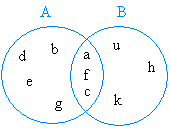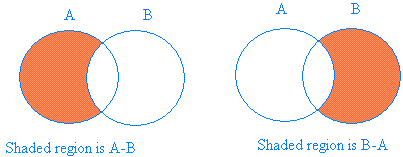Difference of sets
This lesson will explain how to find the difference of sets. We will start with a definition.Given set A and set B the set difference of set B from set A is the set of all element in A, but not in B.
We can write A − B
Example #1.

Take a close look at the figure above. Elements in A only are b, d, e, and g.
Therefore, A − B = { b, d, e, g}
Notice that although elements a, f, c are in A, we did not include them in A − B because we must not take anything in set B.
Then, we show in bold the elements that are in A, but not in B.
A = {b, d, e, g, a, f, c}
B = { k, h, u, a, f, c}
Example #2.
Let A = {1 orange, 1 pineapple, 1 banana, 1 apple}
Let B = {1 orange, 1 apricot, 1 pineapple, 1 banana, 1 mango, 1 apple, 1 kiwifruit }
Find B − A
Notice that this time you are looking for anything you see in B only
Elements that are in B only are shown in bold below.
B − A = {1 apricot, 1 mango, 1 kiwifruit}
Example #3.
Find A − B
B = { 1, 2, 4, 6}
A = {1, 2, 4, 6, 7, 8, 9 }
What I see in A that are not in B are 7, 8, and 9
A − B = { 7, 8, 9}
Example #4.
Find B − A
A = { x / x is a number bigger than 6 and smaller than 10}
B = { x / x is a positive number smaller than 15}
A = {7, 8, 9} and B = { 1, 2, 3, 4, 5, 6, 7, 8, 9, 10, 11, 12, 13, 14}
Everything you see in bold above are in B only.
B − A = {1, 2, 3, 4, 5, 6, 10, 11, 12, 13, 14}
The graph below shows the shaded region for A − B and B − A
